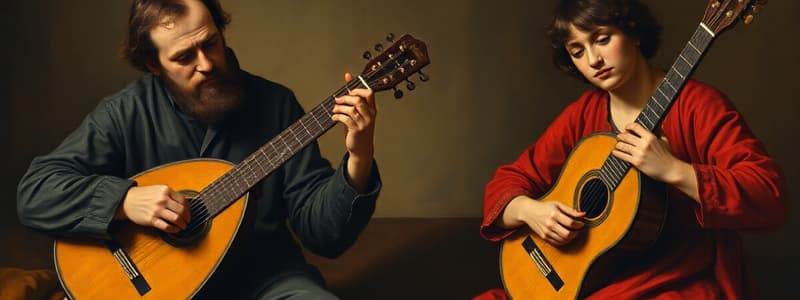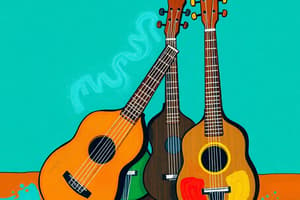Podcast
Questions and Answers
Which characteristic distinguishes the electric guitar from other guitars?
Which characteristic distinguishes the electric guitar from other guitars?
- Its strings are made of nylon.
- It has a rounded resonating body.
- It relies on an electronic pickup to amplify the sound. (correct)
- It is primarily used in classical music.
What is a defining feature of the banjo that sets it apart from other stringed instruments?
What is a defining feature of the banjo that sets it apart from other stringed instruments?
- Its primary use in rock music.
- Its origin in European classical music.
- Its resonator covered with a membrane. (correct)
- Its use of nylon strings.
How does the sound production of a harpsichord differ from that of a piano?
How does the sound production of a harpsichord differ from that of a piano?
- The harpsichord's volume is controlled by the force with which the keys are pressed.
- The harpsichord produces sound by striking the strings with hammers.
- The harpsichord plucks the strings, resulting in a sound that is not dependent on the key's force. (correct)
- The harpsichord uses pedals to dampen the strings.
What is the typical number of strings found on an E-Bass?
What is the typical number of strings found on an E-Bass?
Which instrument is characterized by having its strings stretched over a trapezoidal frame and struck with small hammers or beaters?
Which instrument is characterized by having its strings stretched over a trapezoidal frame and struck with small hammers or beaters?
How does a modern piano achieve its wide tonal range and sustain the tension of its strings?
How does a modern piano achieve its wide tonal range and sustain the tension of its strings?
Which instrument is plucked with a plectrum and often features rapid note repetition known as tremolo?
Which instrument is plucked with a plectrum and often features rapid note repetition known as tremolo?
What is a key characteristic of the lute that distinguishes it from the guitar?
What is a key characteristic of the lute that distinguishes it from the guitar?
How do the pedals on a concert harp affect the instrument's sound?
How do the pedals on a concert harp affect the instrument's sound?
Which historical period is particularly associated with the harpsichord?
Which historical period is particularly associated with the harpsichord?
Which of the following instruments is played by plucking strings with both hands while it rests horizontally?
Which of the following instruments is played by plucking strings with both hands while it rests horizontally?
What is the likely origin of the guitar?
What is the likely origin of the guitar?
Where did the banjo originate and in which musical genre did it become popular?
Where did the banjo originate and in which musical genre did it become popular?
Which of the following distingushes the E-Bass from other bass instruments?
Which of the following distingushes the E-Bass from other bass instruments?
What feature allows the player to influence the volume on a piano?
What feature allows the player to influence the volume on a piano?
How does an electric guitar amplify sound?
How does an electric guitar amplify sound?
What is the role of the pedals on a concert harp?
What is the role of the pedals on a concert harp?
Which of these instruments used to be popular in noble societies, but in modern times is more commonly used in folk music?
Which of these instruments used to be popular in noble societies, but in modern times is more commonly used in folk music?
Which instrument uses both melody and accompaniment strings and rests in front of the player?
Which instrument uses both melody and accompaniment strings and rests in front of the player?
Which instrument has its origins linked to African lutes brought to America by enslaved people?
Which instrument has its origins linked to African lutes brought to America by enslaved people?
Flashcards
Laute (Lute)
Laute (Lute)
An ancient stringed instrument popular in the Renaissance, often with a bent neck and up to 20 strings.
E-Gitarre (Electric Guitar)
E-Gitarre (Electric Guitar)
An electric guitar detects string vibrations via electromagnetic pickups, amplified through a loudspeaker, used in rock music.
Harfe (Harp)
Harfe (Harp)
A stringed instrument with early forms dating back 5000 years. Modern orchestral harps have around 50 strings.
Mandoline (Mandolin)
Mandoline (Mandolin)
Signup and view all the flashcards
E-Bass (Electric Bass)
E-Bass (Electric Bass)
Signup and view all the flashcards
Banjo
Banjo
Signup and view all the flashcards
Gitarre (Guitar)
Gitarre (Guitar)
Signup and view all the flashcards
Zither
Zither
Signup and view all the flashcards
Hackbrett (Dulcimer)
Hackbrett (Dulcimer)
Signup and view all the flashcards
Klavier (Piano)
Klavier (Piano)
Signup and view all the flashcards
Cembalo (Harpsichord)
Cembalo (Harpsichord)
Signup and view all the flashcards
Study Notes
- Study notes on plucked and struck string instruments
Lute
- The lute has ancient predecessors and became a popular ensemble instrument during the Renaissance in Europe (15th century).
- Lutes often have frets like guitars and can have up to 20 strings; their necks are often bent.
Mandolin
- The mandolin with its pear-shaped body originated in Naples, Italy, and became a folk instrument.
- Mandolins often have 4-6 double strings plucked with a pick(plectrum), either simply or with rapid tremolo.
Banjo
- The banjo is a plucked instrument developed in America, especially played in Jazz bands.
- Characteristic is a sound body (tambourine) with a skin.
- The banjo evolved from long-necked African lutes brought to America by slaves.
Guitar
- Guitar predecessors were likely brought to Spain by the Arabs.
- The guitar spread throughout Europe by the 14th century.
- The non-electric classical guitar is also called an acoustic guitar.
- Modern guitar strings are often made of nylon and have 6 strings.
Electric Guitar
- The vibration of the strings is scanned by an electromagnetic pickup
- Relayed to an amplifier and reproduced via a loudspeaker.
- Effects and unique sounds enable various additional devices.
- The instrument is considered a driving force in modern rock groups.
E-Bass
- Usually when bass is mentioned in rock music, it refers to electric bass.
- Similar to an electric guitar, the typical 4-string electric bass requires an electric amplifier.
Zither
- Zithers are widespread in Africa, Asia (e.g., China, Japan), and Europe, where they are popular folk instruments.
- Zithers feature a flat soundbox, placed on the player with strings plucked by both hands (5 melody strings with metal frets, about 40 accompaniment strings).
Dulcimer
- The dulcimer is a zither that is struck with spoon-like hammers or mallets, with the strings stretched across a trapezoidal frame (board zither).
- The dulcimer was especially popular in upper-class societies.
- Today, it is primarily a folk instrument.
Harp
- Early forms of the harp were known in Egypt around 5000 years ago.
- Modern orchestral harps can have about 50 strings that can be played individually or in chords.
- Each string can be tuned to three different notes using pedals.
Piano
- The piano has a large tonal range, surpassed only by the organ.
- The first instrument whose strings were struck with small hammers originated around 1700.
- Modern pianos require a cast iron frame to withstand strong string tension.
- The volume can be influenced by the force with which a key is struck.
- When the player releases the key the string is muted.
Harpsichord
- The harpsichord has a similar shape to a piano.
- The strings are plucked with quills instead of being struck with hammers.
- The volume of the harpsichord does not depend on the force of the touch.
- The harpsichord was particularly popular during the Baroque period around 1600.
Studying That Suits You
Use AI to generate personalized quizzes and flashcards to suit your learning preferences.




